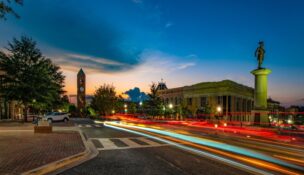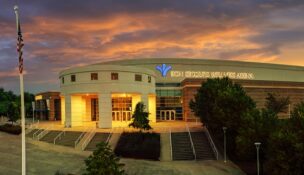Patriots Point misses projection by $600,000
Staff //February 4, 2019//
Seven months into its fiscal year, Patriots Point is over half a million dollars behind its revenue projections, in large part because of a decline in attendance at the Naval & Maritime Museum.
“We based our projected revenue for FY2019, to a great extent, on the successes of FY2018,” said Patriots Point executive director Mac Burdette in a January letter to the Patriots Point Development Authority’s finance committee. “Unfortunately for reasons we cannot fully understand or explain, FY2019 has not proved to mirror FY2018 in terms of revenue.”
Patriots Point broke its annual attendance record in the 2018 fiscal year, which runs from July 1 through June 30.
Kevin Mills, president and CEO of the S.C. Aquarium, said the aquarium has also seen a change in attendance patterns: out-of-state visitors fell by 3% in 2018, but local visitors grew by 2.5% in the same time period.
Perrin Lawson, deputy director of the Charleston Area Convention and Visitors Bureau, said weather has put a damper on tourism in recent months, but people are still coming; nights booked at area hotels grew by 2% in the 2018 calendar year.
The budget approved by the Patriots Point Development Authority in June projected a revenue of $13.78 million for the fiscal year, but Burdette said Patriots Point is $600,000 behind projections for the first six months of the year.
Burdette said, though, that he’s committed to making sure Patriots Point ends the year with a balanced budget.
“We run it like a business,” he said. “We are a state agency, and this is public money, and we take very seriously our commitment.”
Burdette told the Business Journal that Patriots Point typically spends 3% less than what is budgeted by the board. He said in his letter that although the board budgeted $13.14 million for expenditures in the 2019 fiscal year, he anticipates only spending $12.7 million.
“Therefore, even if the projected revenue trend continues for the next six months and we found ourselves short of the projected amount of revenues for the year by $1.2 million, our expenditures would exceed revenues by only about $100,000 for the year,” Burdette said in his letter.
Patriots Point has also incurred increased legal costs over the past seven months, including fulfilling requests through the Freedom of Information Act and terminating the authority’s lease with the Medal of Honor Museum Foundation, which Burdette said could not have been anticipated when the budget was written.
Patriots Point spent $198,460 on legal fees during all of the 2018 fiscal year, but between July and September, the museum spent $138,000 for the same line item.
Travel would probably be one of the first things to cut back on, he said, as well as marketing and sales efforts.
“You’d like to think all your budget items are essential, but let’s face it, there’s some that are more essential than others,” he said. “We’re not going to cut the amount of money we’ve got in there for light bills and cut the lights off, or water.”
Burdette said in the worst case scenario, Patriots Point can transfer fund from its unappropriated funds balance, which is currently about $4.3 million.
He added, though, that he doesn’t expect the downward trend to continue for the rest of the fiscal year, especially considering museum attendance during the first month of the calendar year. The museum saw an increase of about 4,600 ticket versus January 2018.
“You still are going to be very cautious for the next six months based on what happened the first six months, but there is evidence that whatever in the world was going on in the first six months, there’s been some correction,” Burdette said.
Soggy fallout
Lawson, of the Charleston Area Convention and Visitors Bureau, said attendance at attractions like Patriots Point can vary and be weather-dependent, which is why the bureau measures tourism by room nights at hotels instead.
Lawson said the first two months of the fiscal year, July and August, “were fantastic,” up 17,000 room nights from the prior year. Then, with the evacuation for Hurricane Florence in September and the anxiety caused by Hurricane Michael in October, “basically, everything we had gained in the first two months as far as growth over prior year, we lost.”
November and December couldn’t make up for it, Lawson said, because of the amount of rain the region got on the weekends.
“There’s so much leisure travel that is really decided very last minute, and everyone has instantaneous, around-the-clock access to weather and weather forecasts,” he said. “I know there were about four or five weekends in a row stretching from November into December where the forecast called for basically 90% to 100% rain the entire weekend and that definitely had an effect on people coming.”
Even with the setbacks, room nights sold were only down by two-tenths of a percent in the final six months of 2018.
“We have every reason to think the spring will be very good,” Lawson said. “All the indicators are there to say that it would be.”
Mills, of the S.C. Aquarium, said it’s “still a question mark” why people visiting Charleston isn’t converting to attractions attendance as it has in years past.
Some theories, Mills said, are that the increased number of attractions in the Lowcountry is fragmenting attendance or that the area is seeing an increased number of repeat visitors.
Burdette said it’s possible that the nation’s “political upheaval” is making potential tourists nervous.
“Who knows psychologically what effect that has on people’s decision to travel?” Burdette said. “It makes people uneasy, I think you can say that.”
Mills said the aquarium is increasing its marketing toward local resident this year and partnering with other attractions in the area to make it easier for people to see more on a single visit.
“If we can grow our local base 2.5% like we just did last year, I think we’ve accomplished a lot in terms of our own sustainability but also it shows a real faith and confidence in the aquarium and its mission,” Mills said.
The aquarium’s fiscal year just began because it lines up with the calendar year, and Mills said the aquarium is about 14% ahead of its forecast so far. Though he doesn’t expect that level of performance for the rest of the year, Mills is optimistic.
“We’re hoping that last year was a blip, but we’re not taking anything for granted,” he said.
a

















